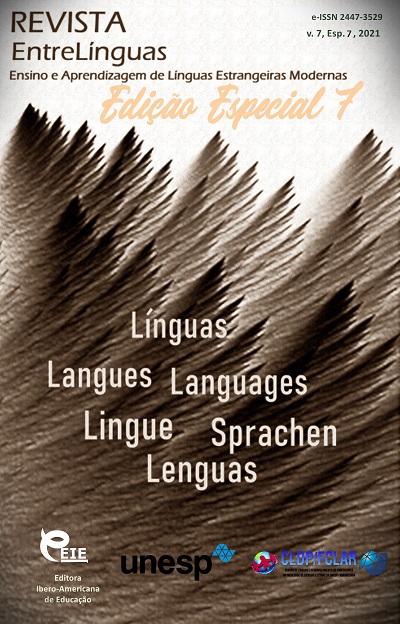Derivational-semantic transformation of auditory perception verbs in typologically distant languages
DOI:
https://doi.org/10.29051/el.v7iesp.7.16307Keywords:
Russian language, Tatar language, Typology, Verb, Word formation, Auditory perceptionAbstract
The article considers the verbs of auditory perception of two typologically distant languages (Russian and Tatar), the morphological structure of which has distinct differences. The purpose of the research is to identify and describe the facts of derivational-semantic transformation of verbs slyshat' / slushat', ishetü / tıñlau (to hear / to listen ) in the aspect of their structural-semantic and functional properties. It was established that the most important content feature of the lexical-semantic group of auditory verbs in both languages is considered to be a sign of the direction of action, relevant for some lexical units and irrelevant for others. Comparative analysis of correlative word-formation nests of auditory perception verbs has revealed similarities and differences in the processes of derivational development and word-formation marking. The different quantitative composition of derived words is explained by the restrictions that determine the compatibility of generating bases with formants, as well as the ways of transformation of basic verbs. During this transformation, both perceptual and mental components of meaning are updated in both languages. Complex and composite Tatar verbs, which motivating base is the words tıñlau (slushat') and ishetü (slyshat'), do not have formal structural analogues in the Russian language, which is the reason for the interlanguage word-formation asymmetry. This disparity is formed by other types of Tatar equivalents: non-derived verbs, phrases, and descriptive constructions. It is proved that the nominative technique of the Russian and Tatar languages in the process of verbalization of auditory perception has its own specificity. It is due to both their grammatical structure and the ethnic nature of the nomination processes
Downloads
References
CHUPRYAKOVA, O., SAFONOVA, S., & ABIKENOVA G. Semantik word formation of dialect verbs: linguoculturological and cognitive aspects. REVISTA GENERO & DIREITO, 8(7), 113-121. 2019.
DOROSHEVSKIJ, V. Elementy leksikologii i semiotiki. Moskva: «Progress», 285 s. 1973.
EPPS, P., & ARKHIPOV, A. (Eds.) New challenges in typology: Transcending the borders and refining the distinctions. Berlin; New York: Mouton de Gruyter, 428 p. 2009.
EROFEEVA, I. Place of derivative adjectives with suffixes -'n- and -'sk- in the Old Russian language (based on chronicles material). Przegląd Wschodnioeuropejski, IX/1, 251-261. 2018.
EVANS, N. Semantic typology. In: The Oxford handbook of linguistic typology. Eds. J.J. Song”. Oxford University Press, 504-533. 2011.
GREGORY, L. Eye and Brain: The Psychology of Seeing. 5 edition. Princeton University Press, 296 p. 2015.
IVASHKEVICH, I. K voprosu o kognitivnoj prirode vospriyatiya i ego otrazhenii v semantike slova. Lingvistika i mezhkul'turnaya kommunikaciya. № 1. S.165-171. 2012.
MERZLYAKOVA, А. Tipy semanticheskogo var'irovaniya prilagatel'nyh polya "Vospriyatie" (na materiale anglijskogo, russkogo i francuzskogo yazykov). Moskva: Knizhnyj dom «LIBROKOM», 352 s. 2012.
MOISEEVA, S. Semanticheskoe pole glagolov vospriyatiya v zapadno-romanskih yazykah: monografiya. Belgorod: Izd-vo BelGU, 248 s. 2005.
NURULLINA, G., LATFULLINA, L., & USMANOVA, L. The valuable potential of the history of learning Turcism in Russian Language. Journal of research in applied linguistics, 10, 424-431. 2019.
PIAGET, J. The mechanisms of perception. London: Routledge & K. Paul, 384 p. 1969.
SAFIULLINA, F. Tatarsko-russkij slovar' odnokorennyh slov, ok. 4000 gnezd, 19 000 slov”. Z.N.Kirillova, A.SH.Yusupova, I.G.Miftahova. Kazan': Kazanskij gos. universitet, 468 s. 2007.
SHCHUKLINA, T. Occasional word-formation as a dynamic aspect of the Russian language derivational system. Przeglad Wschodnioeuropejski, 10(1), 445-452. 2019.
SHOPEN, T. Language typology and syntactic description. Volume II: Complex Constructions. Cambridge University Press, 488 p. 2007.
TEKIN, Ö. Grundlagen der Kontrastiven Linguistik in Theorie und Praxis. Tübingen: Stauffenburg, 300 p. 2012.
TIKHONOV, A. Slovoobrazovatel'nyj slovar' russkogo yazyka. V 2-h t. Tom 1. Moskva: Russkij yazyk, 856 p. 1985.
VEZHBICZKAYA, A. Semanticheskie universalii i opisanie yazykov. Moskva: Yazyki russkoj kul`tury, 780 s. 1999.
Downloads
Published
How to Cite
Issue
Section
License

This work is licensed under a Creative Commons Attribution-NonCommercial-ShareAlike 4.0 International License.
Os manuscritos aceitos e publicados são de propriedade da Revista EntreLínguas. Os artigos publicados e as referências citadas na Revista EntreLínguas são de inteira responsabilidade de seus autores.
Transferência de direitos autorais – autorização para publicação
Caso o artigo submetido seja aprovado para publicação, já fica acordado que o(s) autor(es) autoriza(m) a UNESP a reproduzi-lo e publicá-lo na EntreLínguas, entendendo-se os termos “reprodução” e “publicação” conforme definição respectivamente dos incisos VI e I do artigo 5° da Lei 9610/98. O artigo poderá ser acessado pela rede mundial de computadores (Internet), sendo permitidas, a título gratuito, a consulta e a reprodução de exemplar do artigo para uso próprio de quem a consulta, desde que haja a citação ao texto consultado. Essa autorização de publicação 328 EntreLínguas, Araraquara, v. 1, n .2, p. 323-328, jul./dez. 2015 não tem limitação de tempo, ficando a UNESP responsável pela manutenção da identificação do(s) autor(es) do artigo. Os artigos publicados e as referências citadas na Revista EntreLínguas são de inteira responsabilidade de seus autores.











